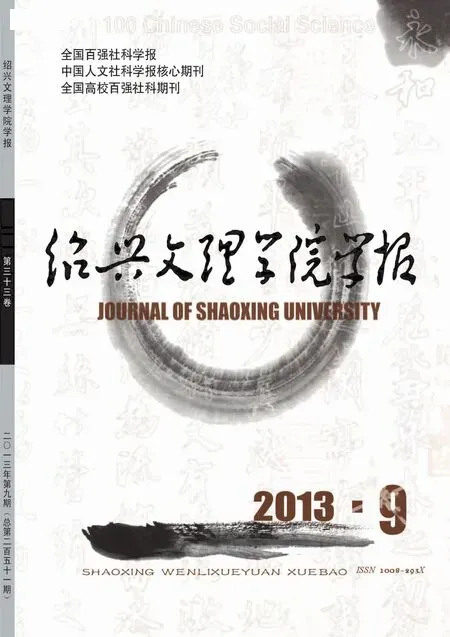The Well-posedness and Regularity of An M/M/1 Queueing Model With Single Vacations
Li Zhiying
(Yuanpei College, Shaoxing University, Shaoxing, Zhejiang 312000)
1 Introduction
The M/M/1 queue has been used in many transportation processes such as buses and elevators.And in telecommunications,especially ATM (Asynchronous Transfer Mode).Researchers have studied it extensively[1-2].Jaiswal[3]set up the mathematical model of the M/M/1 queue and investigated the static solution.He used the probability generating function with the hypothesis:
(1)This model has an unique non-negative solutionP(x,t);

p(x,t)=(p(t),p0(x,t),p1(x,t),…),P(x)=(p,p0(x),p1(x),…).
Researchers have studied it widely,and they have got many results.But the proofs of the two hypothesis above have not been settled[4].
Geni et. al.[5-7]proved the validity of Hypothesis 1,and they took a crucial step to prove Hypothesis 2 under the assumption of constant mean service rates.
In this paper we study the system of differential equations with the model :
(1.1)
(1.2)

(1.3)

(1.4)
p(0)=1,pn(x,0)=0,n=0,1,2,… .
(1.5)
Herep(t) is the probability that the queue is empty and the server is idle at timet,pn(x,t)dxis the probability that at timetthere arencustomers in the queue (not in system,i.e.,queue + service) in (x,x+ dx],μ(x)is the mean service rate of the server,ηis the mean arrival rate of the customer,0 <η< 1.
It is well known that the hypothesis above does not always hold and it is necessary to prove the rightness- Base on this motivation,we investigate the well-posedness and exponential stability of the system in this paper.Furthermore,we show the existence of positive solution and strictly dominant eigenvalue.
In this paper we assume that:μ(x) is a measurable function and
(1.6)
2 The Well-posedness of Solution
forP=(p,p0(x),p1(x),…)∈X.It is easily to see thatXis a Banach space.
Now we define the following operators:A=A1+ηB,where
(2.1)
with the domain
(2.2)
Then the equation systems (1.1)-(1.5) can be written the abstract Cauchy problem:
(2.3)
Theorem2.1 The operator A is a linear closed dense defined one inX.
The proof is a direct verification,so we omit the detail.

P=(p,p0(x),p1(x)…)∈D(A1),Q=(q,q0(x),q1(x)…)∈X*
we have

where we have used the following equalities

(2.4)
with the domain
(2.5)


η[q0(0)-q]=q,
(2.6)
(2.7)

(2.8)
From (2.7)(2.8),we get
(2.9)
(2.10)
Sinceq0(x),qn(x)∈L∞,n∈N,we have
and hence
(2.11)
(2.12)
(x)Ifq≠0,from (2.6)(2.11) we get

We are now in a position to discuss the well-posed-ness problem of the system (1.1)-(1.5) or shortly (2.3).It is well known that if the system (2.3) is well posed,that is ,for each initialP0∈X,there exists unique a solutionP(t)∈X,which depends continuously onP0,then we can define a family of bounded linear operatorsT(t) ∶[0,+∞)→L(X) byP(t) =T(t)P0.By the property of the solution,the family {T(t)}t≥0satisfy the following properties:


Conversely,if there exists a family of bounded linear operator{T(t)}t≥0satisfying the three properties above,thenP(t) =T(t)P0is an unique solution to (2.3).In this case,the family of bounded liner operators {T(t)}t≥0is called strongly continuous semigroup of contraction,or we callC0semigroup of contraction,and A is called the generator ofT(t). Therefore,the well-posed- ness of the system (2.3) is equivalent to the existence ofC0semigroup of contraction.
To prove the existence of the semigroup,the Laplace transformation for (2.3) is often used,this leads to the equation (sI-A)P=P0.Obviously,ifs∈ρ(A),thenP(s) =R(s,A)P0.A question is that the inverse Laplace transform may not exist.
Lumer-Phillips Theorem (see,Ref.[8]) gives a sufficient and necessary condition that A is the generator ofC0semigroup of contraction.
Lemma2.1 (Lumer - Phillips Theorem) LetXbe a Banach space,andX*be the dual space.


(2)There exists aρ>0 such thatR(ρI-A) =X.
, We can use the Lumer-Phillips Theorem to show the well-posed-ness of the system (2.3).
Theorem2.3 The operator A1generates aC0semigroup of contraction.
ProofFirst,for anyP= (p,p0(x),p1(x),…)∈D(A1),we chooseQ= (q,q0(x),q1(x),…) ∈X*, where





Theorem2.4 The operator A generates aC0semigroup onX.The system (2.3) is well-possed.
ProofObviously,Bis a bounded linear operator onX,using the perturbation theory of semigroup[8],we know that the operator A generates aC0semigroup onX.Therefore,the system (2.3) is well-possed.
The existence of positive solution is important to the practical physical state describes in the system (1.1)-(1.5).
Xis a real Banach space,we define a subsetX+ofXby
X+={P=(p,pn(x))∈X|p≥0,pn(x)≥0,n≥0}.

A bounded linear operatorTis said to be positive operator ifTX+⊂X+.AC0semigroupT(t) is said to be a positive semigroup ifT(t)X+⊂X+,∀t≥0.
In order to describe the positive semigroup,we need the following notion.
Definition 2.1[9]LetXbe a Banach lattice,X+be a positive cone ofXand A be a linear operator inX.Denote
if,for anyx∈D(A),there exists aφ∈G(x) such that (Ax,φ)≤0,we say A is called the dispersive operator.
Lemma 2.2 below is from Ref.[9]:
Lemma2.2Xis a Banach lattice and T is a linear closed defined operator onX.ThenTgenerates a positive contractive semigroup if and only ifTis a dispersive operator andR(I-T) =X.
Theorem2.5 The operator A generates a positiveC0contractive semigroup onX.
ProofObviouslyXis a Banach lattice.Lemma 2.1 shows that it is sufficient to prove that A is a dispersive operator.



The desired result follows from Lemma 2.1.
The following result shows the regularity of the system(2.3).

ProofSinceH0∈D(A) andH0>0,thenT(t)H0∈D(A) is a classical solution of the system(2.3).Let
P(t)=(p(t),p0(x,t),p1(x,t),…)=T(t)H0>0,
thenP(t) satisfies (1.1)-(1.5).Note that
:
[1]Chaudhry M L,Templeton J G C.A first course in bulk queues[M].New York:John Wiley and Sons,1983.
[2]Blanc J P C,Iasnogorodski R,Nain P.Analysis of the M/G/1 queueing mode[J].Queue Sys Columbia,1988,3:129-156.
[3]Jaiswal N K,Thiruvengadam K.Simple machine interference with two types of failure[J].Oper Res Scotland,1963,11:624-636.
[4]Chaudhry M L,Gupta U C.Modelling and analysis of M/Ga,b/1/N -A simple alternative approach[J].Queue Sys Columbia,1999,31:95-100.
[5]Geni Gupur,Zhang H-X.Existence and uniqueness of positive solution of M/MB/1 model[M].New York:Adv in MCDM’98.1998:280-285.
[6] Geni Gupur,Li Xuezhi,Zhu Guangtian.Existence and uniqueness of nonnegative solution of M/Gb/1 queueing model[J].Comput Math Appl,2000,39(7/8):199-209.
[7]Geni Gupur.Resolvent set of the M/MB/1 operator[J].Comput Math Appl,2002,44(1):67-82.
[8]Pazy A.Semigroup of linear operators and applications to partial differential equations[M].New York:Springer-Verlag,1983.
[9]Goldstein J A.Semigroups of linear operators and applications[M].New York: Oxford University Press,1985.

